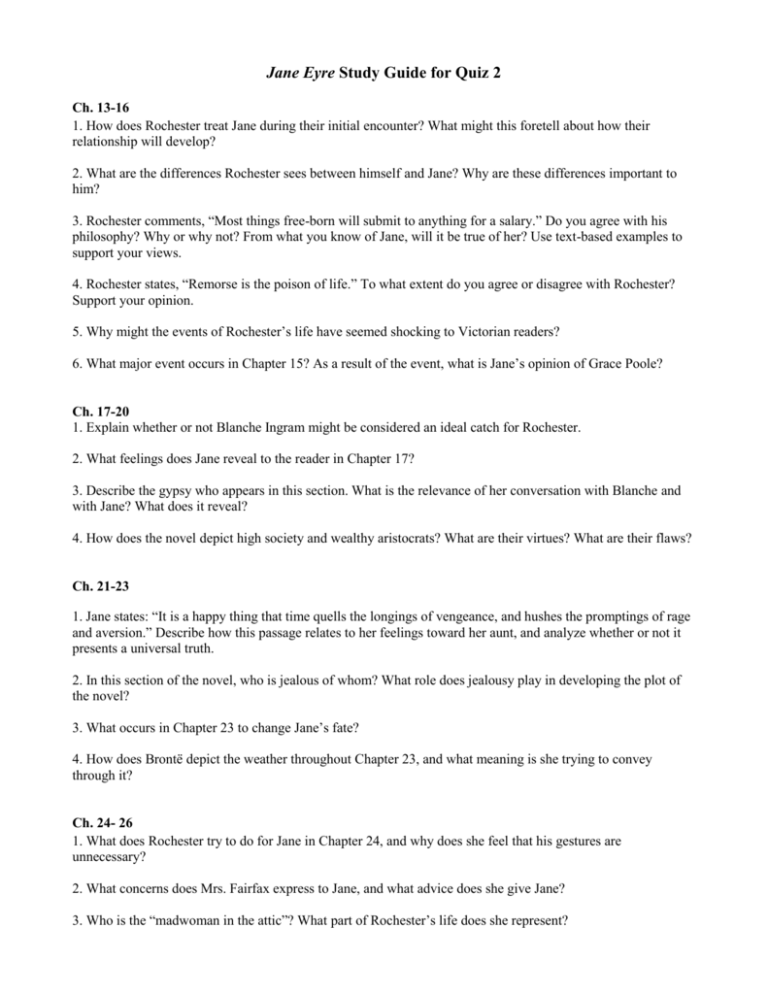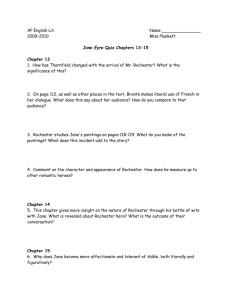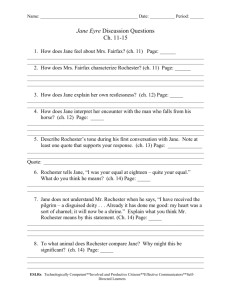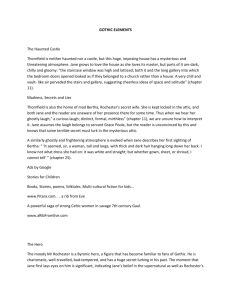Jane Eyre Study Guide for Quiz 2
advertisement

Jane Eyre Study Guide for Quiz 2 Ch. 13-16 1. How does Rochester treat Jane during their initial encounter? What might this foretell about how their relationship will develop? 2. What are the differences Rochester sees between himself and Jane? Why are these differences important to him? 3. Rochester comments, “Most things free-born will submit to anything for a salary.” Do you agree with his philosophy? Why or why not? From what you know of Jane, will it be true of her? Use text-based examples to support your views. 4. Rochester states, “Remorse is the poison of life.” To what extent do you agree or disagree with Rochester? Support your opinion. 5. Why might the events of Rochester’s life have seemed shocking to Victorian readers? 6. What major event occurs in Chapter 15? As a result of the event, what is Jane’s opinion of Grace Poole? Ch. 17-20 1. Explain whether or not Blanche Ingram might be considered an ideal catch for Rochester. 2. What feelings does Jane reveal to the reader in Chapter 17? 3. Describe the gypsy who appears in this section. What is the relevance of her conversation with Blanche and with Jane? What does it reveal? 4. How does the novel depict high society and wealthy aristocrats? What are their virtues? What are their flaws? Ch. 21-23 1. Jane states: “It is a happy thing that time quells the longings of vengeance, and hushes the promptings of rage and aversion.” Describe how this passage relates to her feelings toward her aunt, and analyze whether or not it presents a universal truth. 2. In this section of the novel, who is jealous of whom? What role does jealousy play in developing the plot of the novel? 3. What occurs in Chapter 23 to change Jane’s fate? 4. How does Brontë depict the weather throughout Chapter 23, and what meaning is she trying to convey through it? Ch. 24- 26 1. What does Rochester try to do for Jane in Chapter 24, and why does she feel that his gestures are unnecessary? 2. What concerns does Mrs. Fairfax express to Jane, and what advice does she give Jane? 3. Who is the “madwoman in the attic”? What part of Rochester’s life does she represent? Jane and Rochester’s First Meeting on the Road as Strangers: “Had he been a handsome, heroic-looking young gentleman, I should not have dared to stand thus questioning him against his will, and offering my services unasked” (142). “If even this stranger had smiled and been good-humoured to me when I addressed him…I should have gone on my way…but the frown, the roughness of the traveler set me at my ease” (142). Rochester: “now make haste with the letter to Hay, and return as fast as you can” (144). “it marked with change one single hour of monotonous life…The new face…was like a new picture…and it was dissimilar to all the others…firstly, because it was masculine; and, secondly, because it was dark, strong, and stern. I had it still before me when I entered Hay…I saw it as I walked fast downhill all the way home” (144-145). Jane and Rochester’s Second Meeting at Thornfield Hall: “there was something in the forced stiff bow, in the impatient yet formal tone, which seemed further to express, ‘What the deuce is it to me whether Miss Eyre be there or not?’… I sat down quite disembarrassed. A reception of finished politeness would probably have confused me…I felt interested to see how he would go on” (151). Rochester: “‘I have examined Adele, and find you have taken great pains with her…in a short time she has made much improvement’” (152). Rochester: “‘you have the look of another world…When you came on me in Hay Lane last night, I thought unaccountably of fairy tales, and had half a mind to demand whether you had bewitched my horse’” (153). Rochester: “‘Enough!’…’You play a little, I see; like any other English schoolgirl; perhaps rather better than some, but not well’” (155). Rochester: “I dare say you did exist in a kind of artist’s dreamland while you blend and arranged these strange tints” (158). “he is very changeful and abrupt” (159). Appearance: Beauty vs. Ugliness p. 14 p. 28 p. 112-113 p. 122 p. 196 Jane vs. Blanche: p. 198-202 Jane Through Rochester’s eyes: p. 169 p. 174 p. 189 Rochester p. 142 p. 164-165 p. 184 p. 219-220 p. 224-225




